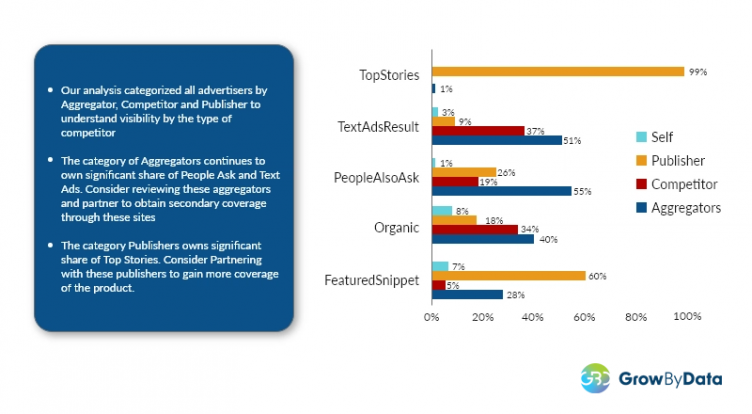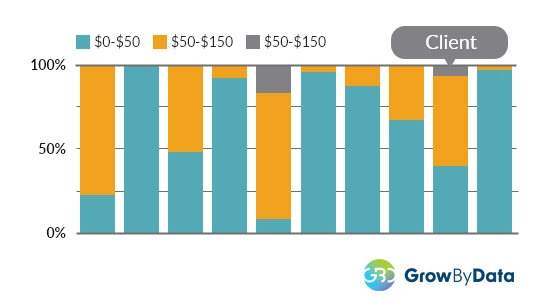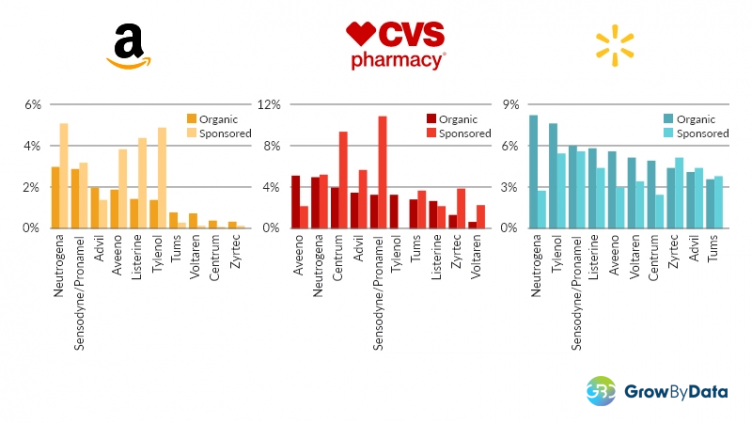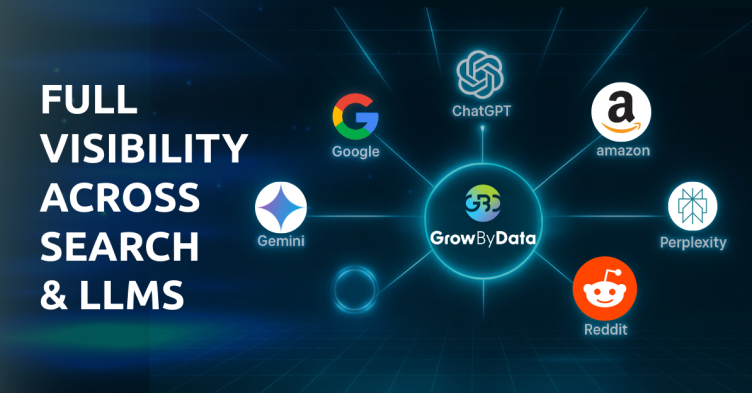The GrowByData Marketing Intelligence platform delivers unprecedented visibility into the performance of advertisers and competitors on Search Engines by providing a highly scalable and customizable SERP Monitoring engine that directly connects to our customized or out-of-the-box Business Intelligence tools for visualization. It has many features like Search Marketing Intelligence, Competitive Product Experience Intelligence, Marketplace Intelligence, Pricing Intelligence, MAP Violation Monitoring, and Trademark Protection, and Affiliate Compliance Tracking.
In this case study, we share five instances where our Search Marketing Intelligence Solution generated customized unprecedented strategic insights affecting the performance of our retail & agency clients. We hope these help you see how your brand can gain a competitive advantage using search driven insights.
1. Hyper-Local Targeting with Category Search
Problem: A large omnichannel client was struggling to understand why they were falling behind in certain key geolocations that out-perform offline. They wanted to understand who they were losing to and gain insights into their tactics.
Through zip-code level targeting capabilities from Search Monitoring, this client was able to zero in on specific areas their stores had a footprint and drill down into specific categories of their business. They were expecting to see their largest offline competitors jockeying for position, but what they found instead was a few niche brands that were not on the national roll-ups surgically attacking them in certain markets and categories. This information armed the client with important insight allowing them to devise a strategy based on these niche competitors in the market. Taking full advantage of these competitive insights, the client could determine the optimal approach like outspending these smaller or niche competitors or out-promoting them with aggressive offers.

2. Competitor Categorization
Problem: One of the world’s largest financial services was at a loss for why they weren’t dominating the SERP given their brand authority and large SEO team constantly working on optimizations.
GrowByData partnered with the client to analyze their results. We uncovered that the client didn’t just have competitors but had several different groups of competitors with each group using drastically different business models. Some were publishers and were amazing at building great content, some were simply aggregated offers from various financial services companies, and some were true financial service competitors. With this discovery, the GrowByData team customized the insights to classify competitors into each of these groups. This helped the client better understand which types of competitors owned the SERP and how the client was performing.
Google appeared to be ‘favoring’ aggregator sites over publishers and direct competitors. This was very noteworthy because this one set of competitors had captured most of the above-the-fold visibility on the SERP and had maintained those positions consistently since SERP data was first collected. When looking at it through this lens, the client was able to see that they were ranked #1 in their cluster of competition and potential incremental gains in terms of visibility to further compete against other competitor types. This group-based ranking became a new strategic KPI for the program – how was the client performing across the whole SERP and how were they positioned against their true competitors?

3. Merchandising Dynamics
Problem: A large apparel brand engaged GrowByData to keep a pulse on the evolving SERP, stay ahead of the emerging competition, and monitor swings on visibility against their biggest competitors.
In the first 90 days of the engagement, the GrowByData professional data analytics team identified an emerging competitor that had consistently increased its share of voice every month. This competitor hadn’t previously been on the client’s radar, so they wanted more information on this competitor to share throughout the organization. Using the Head-to-Head Competitive Dynamics report, the client was able to directly compare this emerging competitor’s merchandising to find out exactly where they were coming up short. They found that this emerging competitor had almost twice the visibility on mobile devices and was advertising three times the amount of low-priced ($0-$50) products. This competitor also did not have any ratings or local inventory tags across keywords with local or non-local intent.
The client’s advantages were desktop visibility, a premium assortment of goods, and brick-and-mortar stores to win local demand. With these insights, the client now had better competitive data to update their teams internally. They also now had the necessary information to build an over-arching search strategy.

4. Holistic Search Strategy
Problem: A large advertiser engaged GrowByData to help understand visibility across all SERP features on multiple channels. Their goal was to maximize visibility on their limited advertising spend and not bias too heavily on a particular channel.
GrowByData SERP Monitoring tool scanned hundreds of keywords on channels where the client was present and on those the client was not. The insights allowed the client to see their presence and the competition’s presence on Organic and Paid SERP components. Looking at the results holistically, the client could see areas where they had high visibility and their competition make-up in the area. By analyzing their brand in particular, this advertiser noticed that the client’s brands were investing heavily in certain categories while they had no visibility in others.
This information helped guide the reallocation of ad dollars from channels where the brand had heavily invested towards other growing channels and categories where they had not. The client was able to maintain high visibility in the channels they already had established a strong share of voice and made informed decisions on the best method to enter rising categories they wished to pursue, whether it be Organic optimization or increased Paid Ad spend.

5. Average Price Monitoring
Problem: A large apparel brand reached out to GrowByData based on a trend where they thought higher prices for their ads in ad auctions impacted conversions.
GrowByData ran an average auction price analysis, which showed a significant increase in average auction prices in the first half of the month. We found the price went from a $15 baseline to a $37 average price in their Google Shopping Ads between the first and second week. Drilling down to the granular data showed that several custom products had started to creep into auctions and pushed the average price up. With their average price at times being 5X the cost of the lowest price, their conversions most likely had struggled.




